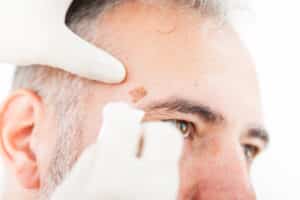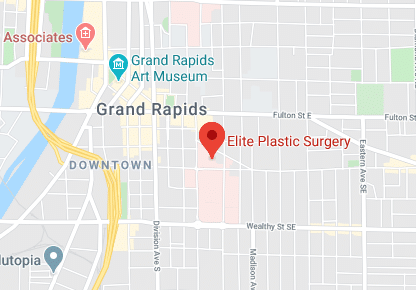What is Skin Cancer?
Skin cancer is the most common form of cancer in the United States. Skin cancer is the result of the abnormal growth of skin cells. Although cancer can affect skin anywhere on the body, it mostly appears on skin exposed to the sun. There are more than a million cases of skin cancer each year in the United States.
Skin cells die everyday and new ones form to replace them. If this process does not work properly, due to damage to DNA, skin cancer can form. If new cells form when they are not needed, or if older cells do not die, a growth of tissue, or tumor, can form. DNA damage can result from exposure to ultraviolet radiation from sunlight or tanning lamps. In some instances, skin cancer can affect skin that has not been exposed to the sun. Some factors can increase the risk of skin cancer, including moles, fair skin, age, heredity, and a weakened immune system.
Types of Skin Cancer
There are three different types of skin cancer than affect different layers of the skin.
- Basal Cell Carcinoma – This skin cancer occurs in the basal cell layer of the skin. It is the most common type of skin cancer in people that have fair skin. It is most common to occur on skin that has been exposed to the sun, like the face. This type of skin cancer rarely spreads to other parts of the body.
- Squamous Cell Carcinoma – This occurs in the squamous cells. It is the most common type of skin cancer in people with dark skin. With dark skin, it typically is found in the legs, feet, or other areas not exposed to the sun. For people with fair skin, it usually occurs in areas of the skin that have been exposed to the sun. This includes the face, head, ears and neck. Squamous cell carcinoma can spread to other parts of the body.
- Melanoma – This is the most aggressive type of cancer that is likely to spread to other parts of the body. It occurs in the melanocyte (pigment) cells of the skin. It can form on any part of the body, regardless of sun exposure.
Dr. Cullen on Malignant Melanoma
Skin Cancer Treatment
Treatment of skin cancer depends on the type, size, and location of the tumor on the body. Many types of skin cancer can be treated with surgical involvement including removal and reconstruction of skin cancer. As cosmetic surgeons, we will plan the removal or reconstruction of the skin cancer to achieve the best aesthetic result possible without compromising your cancer treatment.
What are the Causes of Skin cancer?
Ultraviolet light is the primary cause of the vast majority of skin cancers. This is a range of light that is in sunshine. Tanning lamps also work via ultraviolet light. Sunshine isn’t all bad; it does help induce the natural production of vitamin D. That said, tanning is never a good idea. Studies indicate that the risk of all types of skin cancer is higher in people who suffered one or more blistering sunburns in childhood. Prolonged exposure to sunlight or tanning lamps throughout life also contributes to an elevated risk.
What are the Symptoms?
Skin cancer symptoms can vary based on the type of cells that are involved.
Signs of basal cell carcinoma include:
- A persistent or recurrent sore that crusts, oozes, or bleeds
- A patch of red or irritated skin that hurts, itches or crusts
- A shiny bump that appears white, pink, brown, black, or clear and has a pearly sheen
- A flat area that appears as a scar and has a yellow or white, waxy look
- A flesh-toned or pink growth with a raised edge and indentation at its center
Signs of squamous cell carcinoma include:
- A rough, thick, scaly patch of skin that crusts or bleeds
- A growth that looks like a wart or an open sore that never fully heals
- A growth with raised edges and an indented center that bleeds or itches
Signs of melanoma skin cancer include:
The best-known signs of melanoma are expressed as the ABCs. They include:
- Asymmetry in a mole or growth
- An irregular Border around a growth
- Abnormal Color in a mole or growth, such as varying hues of brown or black
- Diameter that is larger than about one-quarter inch, the size of a pencil eraser
- Any growth that is Evolving over time, including increased size or a change in shape or color
Another way to spot a growth that may indicate melanoma is to look for what is called the Ugly Duckling. As you perform skin checks on yourself, you’ll get to know what looks normal for you. If one spot looks different from others, such as being lighter or darker or larger or smaller, it should be examined by your doctor.
How is Skin Cancer Diagnosed?
Your doctor may suspect skin cancer based solely on the appearance of a growth. However, suspicion does not warrant treatment. Your diagnosis will likely be confirmed via a skin biopsy. This is a simple sampling of tissue that is sent to a pathology lab for examination. Biopsies are often performed as the final test to confirm skin cancer.
How can I Prevent Skin Cancer?
Knowing that skin cancer is primarily caused by DNA damage resulting from exposure to ultraviolet light, your best strategy for prevention is to avoid direct sun exposure. Daily sunscreen use is strongly advised as a convenient method of preventing direct exposure. Broad spectrum SPF 30 sunscreen must be reapplied every few hours as well as anytime you sweat or swim. The use of tanning lamps should also be strictly avoided.
How do I Examine Myself for Skin Cancer?
Your monthly skin cancer exams can be done conveniently after a shower before you dress. It should take just a few minutes to examine all of the skin between your toes and your scalp. Beginning with one or the other, observe all areas of skin, including in between your toes and the bottoms of your feet. Move up to the calves and observe all spots all the way around, then the knees and thighs, the hips and buttocks, and your torso and back. Look between all of your fingers, at your palms, and at the backs of your hands, your forearms, elbows, upper arms, and shoulders. Look at your chest, neck, shoulders, and upper back. Then your ears, lips, and the rest of your face. Using a helper or a mirror, part your hair in multiple places to observe your scalp. You may need to use a handheld mirror to be able to see your backside. A handheld mirror can also be used to check your genital area, where it’s still possible for skin cancer to develop.
If you have questions about how to improve the efficacy of your self-exams, please don’t hesitate to contact us.
How Often Should I Have a Skin Check from a Doctor?
If you have a normal risk of skin cancer, you should see your dermatologist once a year for a thorough skin cancer screening. If you have one or more known risks, such as having fair skin or having had multiple sunburns in your life, your dermatologist may want to see you more frequently.
Skin Cancer Removal
Depending on the location and size of the lesion, we remove it in a variety of ways. Each case is unique. The following are the general steps as to how we would go about removing any sort of cancerous lesion:
Anesthesia
We will administer anesthesia to the patient for comfort during the procedure. We offer local and general anesthesia. Once you have your consultation, our specialist will advise you which is best for your circumstance.
Removal

For small or contained cases, we are able to removal them with excision. This is a simple surgical process that removes the lesion from the designated area of concern. Closure is often performed at the time of the excision.
More intensive cases and lesions are a bit more complicated. What is seen on the outside is sometimes only a portion of the growth. In these cases, Mohs surgery may be recommended to completely remove the cancerous lesion. There is an alternative technique that can be utilized called frozen section closure. During this procedure, the lesion is removed and then examined microscopically to ensure that all cancerous cells have been removed.
These procedures are aimed to achieve a “clear margin”. If the cancerous cells do not spread to healthy tissue, the post-op wound is then reconstructed. If the cancerous cells spread, your surgeon will have to remove more tissue until clear margins are seen.
Skin Cancer Reconstruction

During reconstruction, we take healthy adjacent tissue and place it over the wound. The sutures are positioned to follow the natural curves and features of your face to minimize the resulting scar.
Depending on your circumstance, we may use a skin graft instead. This is when we remove a thin layer of skin from one area of the body and place it on the wound.
During your consultation, our surgeons will determine what option would be best for you.
Recovery After Skin Cancer Treatment
After treatment the wound may be sore, red and drain small amounts of fluid. It is imperative to follow all wound care instructions provided by our surgeon. Cleansing and applying topical medications exactly as instructed will assure you achieve the best possible results. We recommend limiting movement and any stressful activities to keep the wound clean and protect it from possible injuries.
Healing can extend for a couple of months. The more time that it heals, the more the incision lines will continue to improve. It may take up to a year or more for incision lines to refine and fade to a certain degree. Follow up procedures may be necessary to complete and refine your results.
Sun exposure can lead to irregular pigmentation and raise scars. It may turn them red or dark and can increase the risk of developing skin cancer in another region of your body.
Schedule a Consultation
To learn more about Skin Cancer Removal and Reconstruction, or to schedule a consultation, call (616) 459-1907 today! Elite Plastic Surgery serves Grand Rapids, MI and surrounding areas.


